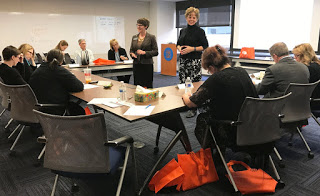Learning Bursts Part Three: Resilience
Learning Bursts Part Three: Resilience
We all know someone who we would describe as resilient. A family member who has overcome a challenge, a friend who consistently pushes through difficult situations, or that coworker who always seems to focus on the positives. Although resilience is easy to recognize, it’s not always easy to put into practice. In the third Learning Burst in our four-part series at Peirce College, Beneficial Bank, we discussed exactly that: how to be resilient in the workplace.
The Resilience P.U.M.P.
- P = Pause (detachment breaks)
- U = Understand (remain fact-based)
- M = Manage (emotional and mental agility)
- P = Perspective (think big picture; cultivate compassion)
The more you utilize the techniques above, the more natural these responses will become and the stronger your resiliency muscle will be.
To help illustrate this point, Thompsonowak asked the participants to put these tools to work. Through group activities, personal stories and honest discussions, the attendees discovered the practical uses of these methods and the positive effect they can have on their overall work experience.
Thompsonowak ended by explaining the dangers of deflating thoughts and how they can negatively impact our ability to be resilient. The five most common deflating thoughts that can derail our resiliency are highlighted below.
Deflating Thoughts
- Focus on Self – “It’s all my fault”
- Focus on Others – “It’s all his/her fault”
- Inadequacy – “I’m a terrible, inferior person”
- Catastrophizing – “It the end of the world. I can’t handle this.”
- Helplessness – “This is going to ruin my whole life.”
Avoiding the deflating thoughts above gives us the opportunity to be resilient and move past situations in positive, healthy ways.
Littlefield and Thompsonowak will conclude their Learning Burst series next month with a session on Positive Outlook.
Peirce College and Beneficial Bank have been valued partners since 2008. Beneficial employees, spouses and dependents are eligible for a 25% tuition discount at Peirce College. To learn more about enrolling at Peirce, please visit www.peirce.edu/apply.
For a complete list of all corporate partners, please visit www.peirce.edu/corporate-partners. If your company is not listed and you would like to be considered for partnership, please contact Amy Holvey, Manager of Corporate Enrollment at alholvey@peirce.edu.
- Prev Post
- Next Post
© 2024 Peirce College. All rights reserved.


LeaveComment